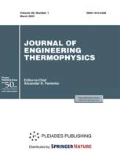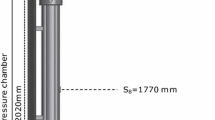Abstract
We present a numerical model suitable for simulation of shock or blast waves passing through a cloud of water droplets. The model takes into account the droplet breakup, radiation, and evaporation effects. The gas phase (a mixture of air and water vapor) is solved within an Eulerian framework with a set of compressible transport equations. The disperse phase (water droplets) is represented by a number of Lagrangian parcels of a specified size and mass distribution. The model has been verified with experimental data. The results show that for large (millimeter-sized) droplets with high Weber numbers, the breakup model is the most important part for accurate representation of the wave-droplet interaction phenomena, while for very fine droplets (1 \(\mu\)m or less), the evaporation effects are the strongest in the shockwave mitigation process. The radiative heat flux increase due to high droplet emissivity is found to be possible for an intermediate size water droplets (about 10–20 \(\mu\)m) in the case of continuous heat release.
Similar content being viewed by others
REFERENCES
Borisov, A.A., Gel’fand, B.E., Gubin, S.A., Kogarko, S.M., and Krivenko, S.M., Attenuation of Shock Waves in a Two-Phase Gas-Liquid Medium, Mekh Zhidk. Gaza, 1971, vol. 6, no. 5, pp. 892–897.
Adiga, K.C., Willauer, H.D., Ananth, R., and Williams, F.W., Implications of Droplet Breakup and Formation of Ultra Fine Mist in Blast Mitigation, Fire Safety J., 2009, vol. 44, no. 3, pp. 363–369.
Thomas, G.O., On the Conditions Required for Explosion Mitigation by Water Sprays, Trans. Inst. Chem. Engin., 2000, vol. 78, no. 5, pp. 339–354.
Hartman, W.F., Larsen, M.E., and Boughton, B.A., Blast Mitigation Capabilities of Aqueous Foam, Sandia Natl. Lab., 2006, no. SAND2006-0533.
Buzukov, A.A., Decreasing the Parameters of an Air Shock Wave Using an Air-Water Curtain, Combust. Explos. Shock Waves, 2000, vol. 36, no. 3, pp. 395–404.
Tétrault, P. and Seers, P., Potential of a Jet-Induced Shock Wave to Influence an Upstream Droplet Cloud in Compression-Ignition Engines Using Multiple Injection Strategies, Int. J. Multiphase Flow, 2018, vol. 101, pp. 64–73.
Liu, N., Wang, Z., Sun, M., Wang, H., and Wang, B., Numerical Simulation of Liquid Droplet Breakup in Supersonic Flows, Acta Astronautica, 2018, vol. 145, pp. 116–130.
Smolders, H.J. and Van Dongen, M.E.H., Shock Wave Structure in a Mixture of Gas, Vapour and Droplets, Shock Waves, 1992, vol. 2, no. 4, pp. 255–267.
Försth, M. and Ochoterena, R., On the Mitigation of Shock Waves by Exciting Vibrational Modes in Water Droplets, Digitala Vetenskapliga Arkivet, ISBN: 978-91-87461-40-82013, pp. 1–56.
Grant, G., Brenton, J., and Drysdale, D., Fire Suppression by Water Sprays, Fluid Dyn., 2000, vol. 26, no. 2, pp. 79–130.
Pilch, M. and Erdman, C.A., Use of Breakup Time Data and Velocity History Data to Predict the Maximum Size of Stable Fragments for Acceleration-Induced Breakup of a Liquid Drop, Int. J. Multiphase Flow, 1987, vol. 13, no. 6, pp. 741–757.
Sommerfeld, M., The Unsteadiness of Shock Waves Propagating through Gas-Particle Mixtures, Exp. Fluids, 1985, vol. 3, no. 4, pp. 197–206.
Chauvin, A., Jourdan, G., Daniel, E., Houas, L., and Tosello, R., Experimental Investigation of the Propagation of a Planar Shock Wave through a Two-Phase Gas-Liquid Medium, Phys. Fluids, 2011, vol. 23, no. 11, p. 113301.
Liberman, M., Kleeorin, N., Rogachevskii, I., and Haugen, N.E.L., Mechanism of Unconfined Dust Explosions: Turbulent Clustering and Radiation-Induced Ignition, Phys. Rev. E, 2017, vol. 95, no. 5, p. 051101.
Liberman, M.A., Ivanov, M.F., and Kiverin, A.D., Effects of Thermal Radiation Heat Transfer on Flame Acceleration and Transition to Detonation in Particle-Cloud Hydrogen Flames, J. Loss Prev. Process Industr., 2015, vol. 38, pp. 176–186.
Ghasemi Khourinia, A., Numerical Simulation of Non-Reactive Evaporative Diesel Sprays Using OpenFOAM, MSc Thesis, Milan: Politecnico di Milano Press, 2017, pp. 1–79.
López, J.J., Novella, R., Garcı́a, A., and Winklinger, J.F., Investigation of the Ignition and Combustion Processes of a Dual-Fuel Spray under Diesel-Like Conditions Using Computational Fluid Dynamics (CFD) Modeling, Math. Comput. Modelling, 2013, vol. 57, nos. 7/8, pp. 1897–1906.
Zhou, Z.F., Lu, G.Y., and Chen, B., Numerical Study on the Spray and Thermal Characteristics of R404A Flashing Spray Using OpenFOAM, Int. J. Heat Mass Transfer, 2018, vol. 117, pp. 1312–1321.
O’Rourke, P.J., Collective Drop Effects on Vaporizing Liquid Sprays, PhD Thesis, Princeton University, USA, 1981.
O’Rourke, P.J. and Amsden, A.A., The TAB Method for Numerical Calculation of Spray Droplet Breakup, SAE Tech. Pap., 1987, no. 872089, pp. 1–10.
Ranz, W.E. and Marshall, W.R., Evaporation from Drops,Chem. Eng. Prog., 1952, vol. 48, no. 3, pp. 141–146.
Boulet, P., Collin, A., and Consalvi, J.L., On the Finite Volume Method and the Discrete Ordinates Method Regarding Radiative Heat Transfer in Acute Forward Anisotropic Scattering Media,J. Quant. Spectr. Rad. Transfer, 2007, vol. 104, no. 3, pp. 460–473.
Barlow, R.S., Karpetis, A.N., Frank, J.H., and Chen, J.Y., Scalar Profiles and NO Formation in Laminar Opposed-Flow Partially Premixed Methane/Air Flames, Combust. Flame, 2001, vol. 127, no. 3, pp. 2102–2118.
Rivière, P. and Soufiani, A., Updated Band Model Parameters for H\(_2\)O, CO\(_2\), CH\(_4\) and CO Radiation at High Temperature, Int. J. Heat Mass Transfer, 2012, vol. 55, nos. 13/14, pp. 3349–3358.
Kuznetsov, G.V., Piskunov, M.V., Volkov, R.S., and Strizhak, P.A., Unsteady Temperature Fields of Evaporating Water Droplets Exposed to Conductive, Convective and Radiative Heating, Appl. Therm. Engin., 2018, vol. 131, pp. 340–355.
Antonov, D.V., Kuznetsov, G.V., and Strizhak, P.A., Differences of Two-Component Droplets Breakup at the High Temperatures, J. Energy Inst., 2019; https://doi.org/10.1016/j.joei.2019.02.005, pp. 1–16.
Author information
Authors and Affiliations
Corresponding author
Rights and permissions
About this article
Cite this article
Hrebtov, M.Y., Bobrov, M.S., Zhakebayev, D.B. et al. Mixed Lagrangian-Eulerian Simulation of Interaction between a Shockwave and a Cloud of Water Droplets. J. Engin. Thermophys. 29, 254–263 (2020). https://doi.org/10.1134/S1810232820020071
Received:
Revised:
Accepted:
Published:
Issue Date:
DOI: https://doi.org/10.1134/S1810232820020071




